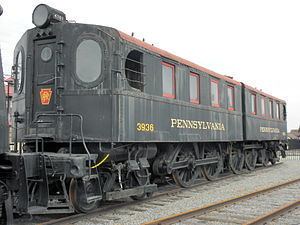Power type Electric AAR wheel arr. 2-B+B-2 Area 404.7 m² | Build date 1911 Driver dia. 72 in (1,829 mm) Builder Altoona Works | |
 | ||
Gauge 4 ft 8 ⁄2 in (1,435 mm) Length 64 ft 11 in (19.8 m) overall Operators Pennsylvania Railroad, Penn Central Transportation Company | ||
PRR 3936 and 3937, formerly 4781 and 4780 respectively, are a pair of DD1-class electric locomotives located in the Railroad Museum of Pennsylvania in Strasburg, Pennsylvania. The two locomotives form a married pair and were assigned an EZN of 36. The locomotives were put into service in 1911 and operated in the tunnels beneath the Hudson River between New Jersey and New York City until being relegated to yard work in 1924. 3936 and 3937 were donated to the Railroad Museum of Pennsylvania by Penn Central and are the only surviving locomotives of its class. They were listed on the National Register of Historic Places in 1979.
Contents
Design
Locomotives 3936 and 3937 consist of two separate DD1-class locomotives semi-permanently coupled back-to-back. Together, the pair have length of 64 feet 11 inches (19.8 m) and weigh 313,000 pounds (142,000 kg). DD1-class locomotives were nearly always operated as a pair—never individually and rarely as two pairs in a double-heading configuration. The locomotives were assigned an "Electrified Zone Number" (EZN) of 36; the EZN simplified train dispatching for each pair of DD1 while their original individual serial numbers were used for the mechanical records of the locomotives.
Each locomotive had its own Westinghouse 315-A, direct current, commutating pole, electric motors within a monocoque cab. The motors had a continuous power rating of 1,580 horsepower (1,180 kW) at 58 miles per hour (93 km/h), and could produce up to 2,130 horsepower (1,590 kW) at 38 miles per hour (61 km/h) for no more than an hour. The motors were connected to the two 72-inch (1,829 mm) drivers via a jackshaft and coupling rods. The design of the DD1 served as a transition between steam locomotives and modern electric locomotives. Despite their ungainly appearance, DD1's ran "quietly and smoothly...with no appreciable rod clanking", and had a very low maintenance cost. DD1 locomotives operated off of 650 volt direct current from a third rail.
History
The first DD1-class of locomotives were introduced into regular passenger service on November 27, 1910 to operate in the North River Tunnels under the Hudson River. As steam locomotives were prohibited from entering the tunnels, the electric DD1 shuttled passengers from the Pennsylvania Railroad's Manhattan Transfer station in New Jersey and Pennsylvania Station in New York City.
A total of 66 locomotives were constructed by the Pennsylvania Railroad's Juniata Shops in Altoona starting 1909; 3936 and 3937 were put into service in 1911. As the new L5's were being introduced in 1924, most DD1's were transferred to the Long Island Rail Road. Both 3936 and 3937 were shifted from mainline passenger duty, and hauled the empty passenger trains from Pennsylvania Station to the Sunnyside Yard. The Long Island Rail Road scrapped most of their DD1's from 1949 to 1951, and only two pairs remained in 1962. By 1978, 3936 and 3937 were the last DD1 and were donated to the Railroad Museum of Pennsylvania in Strasburg, Pennsylvania, by the Pennsylvania's successor Penn Central as part of a collection with twelve other historical significant locomotives. Both locomotives were jointly listed on the National Register of Historic Places on December 17, 1979.
